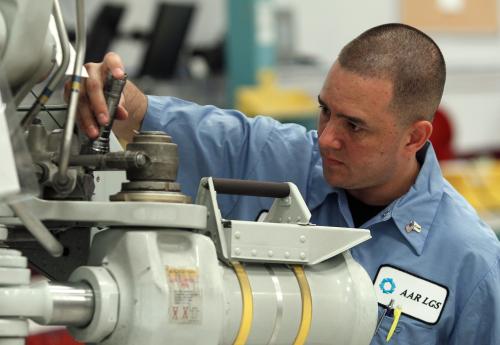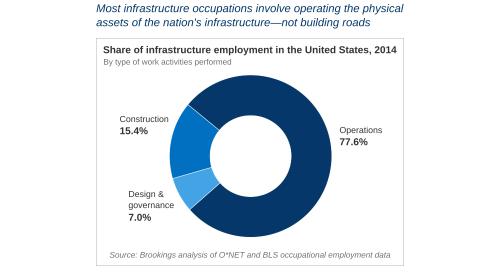Water infrastructure is failing to keep up across the country, as a long list of replacement and maintenance backlogs looms in many communities. Leaks are now wasting more than a trillion gallons of water each year, while overburdened wastewater collection systems are struggling to handle sewer overflows and manage polluted runoff. The recent tragedy in Flint, moreover, has alerted communities of the pressing need to replace public and private lead service lines, adding an estimated $300 billion to the county’s collective water bill.
Although some utilities are making improvements in resource recovery, climate adaptation, and a variety of other innovations that will prepare them for the decades ahead, the nagging reality is that most are not moving fast enough and simply do not have the money to accelerate new improvements. Even as national leaders bring greater visibility to water infrastructure – especially during the election season – states and localities remain the primary drivers for investment, accounting for more than 95 percent of all public spending on water each year.
In response, many utilities are slowly but steadily increasing the water rates that they charge users after years of unrealistically low fees. But where does that leave the households and businesses who are already struggling to make ends meet?
In Detroit, for instance, it is easy to see the tension between the revenue needs for infrastructure maintenance and the personal impact of the rising cost of water. On one hand, activists are pushing back on policies that have escalated water shut-offs for families that fall behind in paying their water bills, claiming that it creates unreasonable stress and adds to the city’s already debilitating foreclosure burden. On the other, the city is slowly emerging from bankruptcy and is under court orders that prevent it from giving water away for free.
Detroit is an extreme example, but it is not alone. Many regions are struggling to keep up with mounting water infrastructure needs and debt obligations, while experiencing unpredictable revenues in the face of changing consumer demands, technological upgrades, and extreme climate pressures. In turn, water rates are increasing in many cities nationally, with some estimates showing that the average monthly residential bill has gone up by 48 percent since 2010.
Indeed, relative to other expenses, households have seen the price of water and sewer services soar over the past two decades. From 2000 to 2016, water and sewer prices have more than doubled in relative terms, far exceeding the price increases of electricity, rent, and gasoline, according to the Consumer Price Index. Combined with stagnating incomes, these rising prices are becoming an understandable source of concern, which are also commonly reflected in other rate surveys that come out each year.

Of course, higher water prices represent only part of the broader investment and affordability challenge. Even as many lower-income households bear the brunt of higher water bills, utilities may not always weigh revenue needs with equity concerns. When considering new rate designs, utilities may find it difficult to address – or even overlook – how customers across income brackets will be affected over time.
For example, when complying with federal requirements for clean water and drinking water, utilities often follow the Environmental Protection Agency’s narrowly-defined “affordability criteria,” which focus on average bills as a percentage of local median household income (MHI), usually around 2.5 percent. Increasingly, this measure has attracted criticism from policymakers and groups nationwide since it does not take into account the most vulnerable users who can spend nearly twice that share or more on their water bills.
In order to drive new water infrastructure investments and accurately assess affordability issues, regional leaders must take a more nuanced approach. At a local level, for instance, utilities can benefit from a clearer assessment of the equity of municipal water rates, which ideally can examine a range of different economic indicators and allow for an easier comparison of different rate structures. Likewise, by accounting for fundamental neighborhood and housing differences, utilities and their state partners can look to a more comprehensive set of measures to guide future policy decisions and affordability concerns. The creation of more robust customer assistance programs, which can provide discounts and extended payment options, also have the potential to lower barriers and provide relief to individuals who currently struggle to keep up with their bills. Nationally, continued discussions over water affordability and other federal technical guidance can further aid these efforts.
Ultimately, regions face an enormous water infrastructure challenge that not only requires increased investment, but also a balancing of other long-term economic priorities. Addressing affordability needs to be a big part of that effort, but accounting for equity concerns can be incredibly complex and will likely demand better data, more targeted policies, and new models of financial support. As the water infrastructure gap continues to widen, the time is ripe for regions to experiment with new approaches and address water demands in a more sustainable and equitable manner.
The Brookings Institution is committed to quality, independence, and impact.
We are supported by a diverse array of funders. In line with our values and policies, each Brookings publication represents the sole views of its author(s).







Commentary
Striking a better balance between water investment and affordability
September 12, 2016